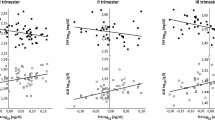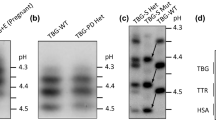Abstract
A new type of serum albumin, that shows a markedly enhanced binding activity for 3,3′, 5-triiodothyronine (T3), a somewhat increased activity for thyroxine (T4), and a normal activity for 3, 3′, 5-triiodothyronine (rT3) is described. This albumin was found in a patient with Graves’ disease. After successful subtotal thyroidectomy, the existence of abnormal binding activity for T3 was suspected in this patient because of persistently increased total T3 concentrations in spite of elevated thyrotropin levels. Although free T3 and T4 concentrations measured by radioimmunoassay using commercial tracer analogue kits were markedly increased, those measured by equilibrium dialysis were within normal ranges. Electrophoretic studies revealed that these abnormalities were due to the markedly increased T3 binding activity by the serum albumin; that for T4 was also slightly increased. Scatchard plot analysis revealed that the association constant (Ka) for T3 of the patient’s albumin was 5.1 × 106/M (normal pooled albumin; 6.2 × 105/M), and those for T4 and rT3 were 5.2 × 106/M and 2.7 × 106/M, respectively (normal pooled albumin; 2.1 × 106/M for both T4 and rT3). The increased binding of albumin to T3 and T4 was markedly inhibited by barbitone, and 8-anilino-1-naphthalenesulfonic acid. These characteristic features, and erroneously high values of free T3 and T4 concentrations measured by tracer analogue kits were similar to those seen in patients with familial dysalbuminemic hyperthyroxinemia, which have been previously reported. These findings strongly suggest that this albumin is a new variant in various dysalbuminemic syndromes, and the abnormal binding of iodothyronines moieties in these syndromes are not biochemically identical.
Similar content being viewed by others
References
Lee W.N.P., Golden M.P., Van Herle A.J., Lippe B.M., Kaplan S.A. Inherited abnormal thyroid hormone-binding protein causing selective increase of total serum thyroxine. J. Clin. Endocrinol. Metab. 49: 292, 1979.
Docter R., Bos G., Krenning E.P., Fekkes D., Visser T.J., Hennemann G. Inherited thyroxine excess: a serum abnormality due to an increased affinity for modified albumin. Clin. Endocrinol. (Oxf.) 15: 363, 1981.
Stockigt J.R., Topliss D.J., Barlow J.W., White E.L., Hurley D.M., Taft D. Familial euthyroid thyroxine excess: An appropriate response to abnormal thyroxine binding associated with albumin. J. Clin. Endocrinol. Metab. 53: 353, 1981.
Ruiz M., Rajatanavin R., Young R.A., Taylor C., Brown R., Braverman L.E., Ingbar S.H. Familial dysalbuminemic hyperthyroxinemia. A syndrome that can be confused with thyrotoxicosis. N. Engl. J. Med. 306: 635, 1982.
Borst G.C., Premachandra B.N., Burman K.D., Osburne R.C., Georges L.P., Johnsonbaugh R.E. Euthyroid familial hyperthyroxinemia due to abnormal thyroid hormone-binding protein. Am. J. Med. 73: 283, 1982.
Lalloz M.R.A., Byfield P.G.H., Himsworth R.L. Hyperthyroxinemia; abnormal binding of T 4 by an inherited albumin variant. Clin. Endocrinol. (Oxf.) 18: 11, 1983.
Lalloz M.R.A., Byfield P.G.H., Himsworth R.L. A new and distinctive albumin variant with increased affinities for both triiodothyronines and causing hyperthyroxinemia. Clin. Endocrinol. (Oxf.) 22: 521, 1985.
Yamamoto T., Doi K., Ichihara K., Miyai K. Reevaluation of measurement of serum free thyroxine by equilibrium dialysis based on computational analysis of the interaction between thyroxine and its binding proteins. J. Clin. Endocrinol. Metab. 50: 882, 1980.
Ingbar S.H., Freinkel N. Regulation of the peripheral metabolism of the thyroid hormones. Recent Prog. Horm. Res. 16: 353, 1960.
Levy H.B., Sober H.A. A simple chromatographic method for preparation of gamma globulin. Proc. Soc. Exp. Biol. Med. 103: 250, 1960.
Yabu Y., Amir S.M., Ruiz M., Braverman L.E., Ingbar S.H. Heterogeneity of thyroxine binding by serum albumins in normal subjects and patients with familial dysalbuminemic hyperthyroxinemia. J. Clin. Endocrinol. Metab. 60: 451, 1985.
Sakata S., Atassi M.Z. Immunochemistry of serum albumin. VI. A dynamic approach to the immunochemical cross-reactions of proteins using serum albumins from various species as models. Biochim. Biophys. Acta 576: 322, 1979.
Scatchard G. The attractions of proteins for small molecules and ions. Ann. N.Y. Acad. Sci. 51: 660, 1949.
Rajatanavin R., Fournier L., DeCosimo D., Abreau C., Braverman L.E. Elevated serum free thyroxine by thyroxine analog radioimmunoassays in euthyroid patients with familial dysalbuminemic hyperthyroxinemia. Ann. Intern. Med. 97: 865, 1982.
Byfield P.G.H., Lalloz M.R.A., Pearce C.J., Himsworth R.L. Free thyroid hormone concentrations in subjects with various abnormalities of binding proteins: Experience with Amerlex free-T 4 and free-T 3 assays. Clin. Endocrinol. (Oxf.) 19: 277, 1983.
Stockigt J.R., Stevens V., White E.L., Barlow J.W. “Unbound analog” radioimmunoassays for free thyroxine measure the albumin-bound hormone fraction. Clin. Chem. 29: 1408, 1983.
Beck-Peccoz P., Romelli P., Cattaneo M., Faglia G. Free T4 and free T3 measurement in patients with antiiodothyronine autoantibodies. In: Albertini A., Ekins R.P. (Eds.), Free hormones in blood. Elsevier, Amsterdam, 1982, p. 231.
Konishi J., Lida Y., Kousaka T., Ikekubo K., Nakagawa T., Torisuka K. Effect of anti-thyroxine autoantibodies on radioimmunoassay of free thyroxine in serum. Clin. Chem. 28: 1389, 1982.
Barlow J.W., Csicsmann J.M., White E.L., Funder J.W., Stockigt J.R. Familial euthyroid thyroxine excess: characterization of abnormal intermediate affinity thyroxine binding to albumin. J. Clin. Endocrinol. Metab. 55: 244, 1982.
Cheng S.-Y., Pages R.A., Saroff H.A., Edelhoch H., Robbins J. Analysis of thyroid hormone binding to human serum prealbumin by 8-anilinonaphthalene-1-sulfonate fluorescence. Biochemistry 16: 3707, 1977.
Author information
Authors and Affiliations
Additional information
This work was supported by a Research Grant-in-Aid (#61570550) from the Ministry of Education, Science and Culture of Japan, and a grant from the Japanes Medical Woman’s Association.
Rights and permissions
About this article
Cite this article
Yabu, Y., Miyai, K., Kobayashi, A. et al. A new type of albumin with predominantly increased binding affinity for 3,3′, 5-triiodothyronine in a patient with Graves’ disease. J Endocrinol Invest 10, 163–169 (1987). https://doi.org/10.1007/BF03347183
Received:
Accepted:
Published:
Issue Date:
DOI: https://doi.org/10.1007/BF03347183




